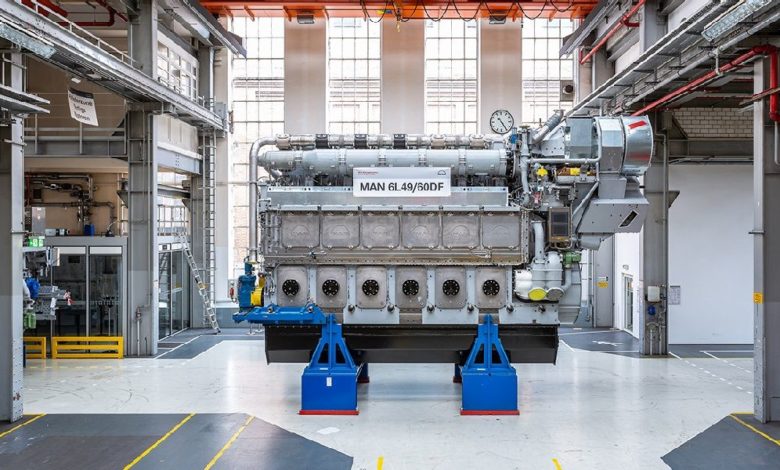MAN reveals new dual-fuel engine at SMM

MAN Energy Solutions has introduced the latest addition to its four-stroke engine portfolio, the dual-fuel engine capable of running on LNG, diesel and HFO as well as a number of more sustainable fuels including biofuel blends and synthetic natural gas.
The MAN 49/60DF engine type is already available for order and is based on the new 49/60 engine platform that features MAN’s latest technologies, including two-stage turbocharging, second-generation common-rail fuel injection, SaCoS5000 automation system and MAN’s next generation adaptive combustion control 2.0 that automatically sets combustion to optimum levels. The engine also retains existing MAN technologies such as the gas-injection system, pilot-fuel-oil system and MAN SCR (selective catalytic reduction) system.
The 49/60 can start in gas mode where it complies with IMO Tier III without secondary measures. In diesel mode, it complies with Tier III combined with MAN’s SCR system. According to the engine designer, soot emissions are halved in diesel mode due to its new common rail system 2.2, while the 49/60DF’s methane emissions are also drastically reduced in gas mode compared to its predecessor.
The engine’s benchmark efficiency and fuel-flexible design offer multiple paths to emission compliance leading up to 2050, as per the current Fuel EU draft, MAN Energy Solutions said, adding that it plans to introduce a pure diesel engine based on the 49/60 platform in 2023 that will inherently be retrofit-ready for running on methanol and LNG should the demand arise at a later stage.
“The MAN 49/60DF is making its debut at a time where – while the number of LNG projects is still growing – alternative fuels like methanol, ammonia and hydrogen are continuing their rise, albeit with none having established market dominance as of yet. Increasingly, it is crucial for new vessels to be driven by engines that provide options for emission compliancy over the vessel’s lifetime. Fuel flexibility and efficiency are the key features. In this respect, the 49/60DF distinguishes itself by offering a number of various emission paths. It also has a level of efficiency that ensures best fuel costs in many applications, especially within the cruise, ropax, roro, dredger, and LNG carrier segments,” explained Marita Krems, head of four-stroke Marine & License at MAN Energy Solutions.
The engine was unveiled at SMM, the world’s largest shipping exhibition, where the company’s executive board member of global sales and after-sales Wayne Jones OBE warned that the marine industry is moving too slowly in relation to decarbonisation and is being held back by a lack of regulations that would incentivise a quicker pick-up of synthetic fuels.
Speaking at a panel discussion on Climate Analysis and Perspectives Jones stated that, without further action, global shipping might significantly overshoot the targets set by the Paris Agreement to limit temperature increase.
He said: “In an earlier analysis with German industry associations, VDMA and VSM, we have shown that – with the appropriate regulatory framework provided – at least in Europe shipping could be climate-neutral by 2045 and not emit any more greenhouse gases after that point. This would be much quicker than projected by the IMO but might still not be quick enough; our current calculations show that the industry would even then fall short of Paris targets because of the overshoot in greenhouse gas emissions accumulating until then. Further action is needed, which also has to focus on the existing fleet.”
Jones’ concern is founded in MAN Energy Solutions’ own analysis of historical and expected CO2 shipping emissions – in part based on OECD projections of maritime fleet development up to 2050 – that predicts a doubling of the maritime fleet and shipping ultimately failing to deliver on the targets of the Paris Agreement in time.
He said: “While shipping easily remains the best transport option in terms of CO2 emissions, we need to minimise an inevitable 2050 emissions overshoot by increasing the speed of greenhouse-gas regulation through specific, ambitious targets. In this respect, while I’m confident that the industry will incentivise newbuildings and encourage dual-fuel take-up, it’s crucial that it also focuses on the challenge posed by the existing, fossil-fuel-burning fleet. Here, it must encourage green retrofits, otherwise any initiatives will have just a negligible effect on total fleet emissions.”
Jones underlined that there were no technological obstacles for CO2 regulation and that technologies for maritime decarbonisation already exist. He also pointed to the strong interest in methanol where the technology is proven and retrofits already possible. Similarly, MAN Energy Solutions will introduce a commercial ammonia engine in 2024, with retrofits also possible.
MAN Energy Solutions’ analysis shows that the supply and demand of green methanol and green ammonia are in balance until 2025 when methanol is projected to take off at scale and by which time ammonia will have made its market debut. Within the next decade, however, the demand for green fuels for shipping will increase steeply, incurring a gap in supply that could potentially lead to a shortage of green fuels and thus curbing decarbonisation.
Jones concluded: “By virtue of its position, MAN Energy Solutions is in a better position than most to assess the future-fuel mix based on dual-fuel contracting. Regulatory bodies must promptly adopt regulations that invite capital into the production of alternative, green fuels. These would fill the gap between the expected demand and actual supply of green fuels up to 2050 that currently works against us reaching the targets of the Paris Agreement; shipping urgently requires large volumes and thus scalability. Simply put, we must create partnerships with like-minded industry partners to drive decarbonisation as the transition is too great for any one player to handle alone.”
